Healthy Eating Habits Among School Children of Government Girls Higher Secondary School Morgah, Rawalpindi
Samina Yasmeen1*, Shair Mohammad Hazara2 and Shubana Kausar3
1Nursing Instructor, College of Nursing Holy family Hospital Rawalpindi, Pakistan
2Nursing Lecturer College of Nursing PIMS G8/3 Islamabad
3Head Nurse Helper Eye Hospital Quetta, Pakistan
Submission: August 25, 2022; Published: September 21, 2022
*Corresponding author: Samina Yasmeen, Nursing Instructor, College of Nursing Holy family Hospital Rawalpindi, Pakistan
How to cite this article: Ogbonna B, Nduka S, Ngwoke K, Anetoh M, Adenola U, et al. Supply Chain Management for Healthcare Commodities: A Growing Need for Health Sector Development in Nigeria. JOJ Nurse Health Care. 2022; 12(4): 555844. DOI:10.19080/JOJNHC.2022.12.555844
Abstract
Introduction: Diet intake and nutrition of children influence their current health status and academic performance and have long term consequences reaching well into their maturity. Purpose: The purpose of this pilot project was to assess the healthy eating habits among school children of government girls’ higher secondary school Morgah, Rawalpindi.
Methods: Cross-sectional descriptive study was carried out to collect data from 30 students through self-structured questionnaire. While using SPSS version 16, frequency and percentages were calculated and presented in tables.
Results: 33.3% students were belonging to 10– 12 years of age and majority students were off- spring of government employees. Around 43.3% student buy eatables items from canteen more than four times in a week. Whereas 43.3% ate eggs only one time in a week.
Conclusion: Majority of students buy eatables items from canteen most frequently and bring their lunch boxes very less time in a week. With recommended approaches it can be modified to develop health eating habits among middle-aged school children.
Keywords: Eating habits; Dietary pattern; Developing countries; Dietary preferences; School age- children
Background and Literature
Diet intake and nutrition of children influence their current health status and academic performance and also have long term consequences reaching well into their maturity. Further, diet preferences and practices acquired during childhood usually persist for life. School years are a time of rapid transition, growth and development. Moreover, during this period eating habits are established and influenced by the child’s parents, family, peer groups, classmates, and teachers [1]. This period can play a crucial role in adopting and practicing new healthy, or unhealthy eating habits, because most children try toseek independence and become less reliant on their parents or caregivers in all aspects of the live [2-4].
Around less than one quarter of the world’s population constitute on school-age children, and about three quarters of these children live in developing countries. A child’s dietary habits acquired early in childhood continue into adulthood [5]. The school going ages form the foundation of future life in terms of physical, emotional and mental aspects and strongly influence the child’s health in her/his adult life. Adequate and appropriate dietary intake is essential in these ages for inculcating healthy eating habits so as to provide nutrients not just for the immediate growth, development and scholastic performance but also for long-term health. The health, physical growth, development and educational performance of schoolchildren depend largely on good nutrition [6].
The dietary habits of individuals /families /communities vary according to socioeconomic factors, regional customs, traditions, seasonal availability of food items etc. While there are various methods of qualitative and quantitative diet surveys, finding a suitable method of assessing dietary intake for the population under study poses, at times several problems. In this pilot study healthy eating habits were assessed through a self-constructed questionnaire from the middle-aged school children. School health nurses, community health nurses, and public health policy makers require data on nutritional intake of school children so that they would be able to formulate nutritional intervention and also for nutritionists and general practitioners to be able to advice parents and care givers regarding the inadequacies in the diet. The purpose of this pilot study was to assess the healthy eating habits among school children of government girls’ higher secondary school Morgah, Rawalpindi.
Methodology
Research Design
A cross sectional descriptive study was carried out in a government girls’ higher secondary school Morgah, Rawalpindi.
Population and Sampling
Due to examination session and pilot study, the school-age children from class 07 were taken as study population with age group of 11-13. Randomly 30 students irrespective of sex, race, and socioeconomic status were selected as study sample. Data was collected in the month of Feb 2019.
Data Collection Process
A formal permission from the head of the school was taken. A constructed questionnaire consist of two section was used. Section 1 consist of demographic variables. Section 2 has 14 questions covering eating habits including habit of eating fruits, meat, butter, eggs, and breakfast: and drinking habit of milk, and water. As well as to assess the purchasing habit of eatables from canteen, routine of hoteling , and sleeping habit on 5-point scale. Point 1, 2, 3, and 4 indicates 1time, 2times in a week respectively, but point 5 indicates daily or more than 4times in a week. This questionnaire was constructed by the help of relevant field person and after detailed review of literature. So, this questionnaire was piloted on school children. Informed consent was taken, and confidentiality were maintained to maintain the code of ethics in research.
Data Analysis
SPSS version 16 was used to analyze the data. Data was entered twice to minimize the chances of error. Descriptive analysis was done. Frequency and percentages were calculated. For graphical presentation Bar charts were used.
Results and Discussion
The data was collected from the 30-school student of class seventh (7th) out of 70 at Government Girls Higher Secondary School Morgah, Rawalpindi. 33.3% student were belonging to 10 – 12 years, 53.3% 13-14 years, 10% 15-16 years and 3.3% above 16 years. 16.7% father of student were government employees, 6.7% private employees and 76.6% other employees e.g. labor, motor mechanic and sale man etc. The 16.7% of student’s father monthly income were less than and equal 15000 rupees, 33.3% from 16000 to 25,000 rupees, 26.7% from 26,000 to 35000 rupees, 10% from 36,000 to 45,000 rupees and 13.3% above 45,000 rupees. The 20% of student’s father education were under matric, 46.7% matric and 33.3% education level were above matric. 96.7% mother were belonged to housewives and 3.3% working women. Among of the mother 93.4% have had no income because of housewives, 3.3% less and equal to 10,000 rupees per month and 3.3% from 11,000 to 20,000 rupees per month. The 46.7% of student’s mother education level were under matric, 30% matric and 23.3% above matric.
Take the Breakfast at Home in a Week
Among 30 students, 3.3% were taken breakfast two (02) times at home in a week, 6.7% three (03) times in a week at home, 10% four (04) times in a week and 80% more than four (04) times in a week at home (Table 1).
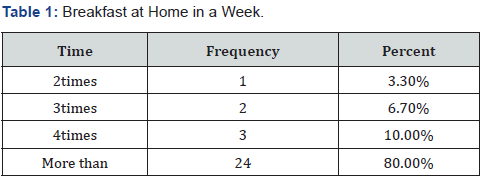
Bring Launch Box from Home in a Week
Out of 30 students, 40% students were brought the lunchbox one (01) time from home in a week, 6.7% two times, 23.3% three times, 10% four times and 20% more than four times (Table 2).
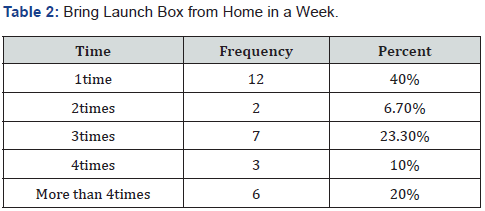
Eat Eggs in a Week
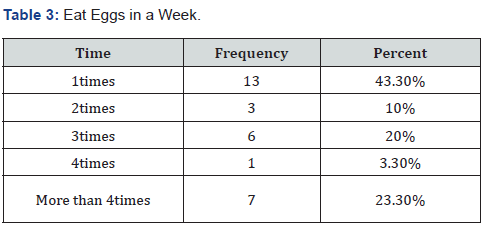
Among students 43.3% ate eggs one time in a week, 10% two times, 20% three times, 3.4% four times and 23.3% more than four times in a week (Table 3).
Eat Meat in a Week
20% students ate meat one time in a week, 26.7% two times, 30% three times, 13.3% four times and 10% more than four times ate meat in a week (Table 4).
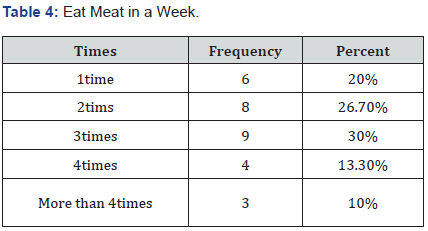
Eat Vegetable in a Week
Out of 30 students, 6.7% ate vegetable one time in a week, 30% two times, 10% three times, 33.3% four times and 20% more than four times ate vegetable in a week (Table 5).
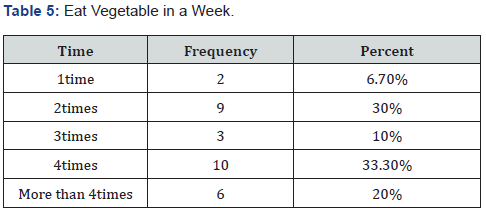
Eat Fruit in a Week
Among of 30 students, 6.7% ate fruit one time in a week, 6.7% two times, 6.6% three times, 26.7% four times and 53.3% more than four times ate fruit in a week. These findings are supported by the study from India as results shows that fruits were consumed by most of the children two to six times a week (Table 6).
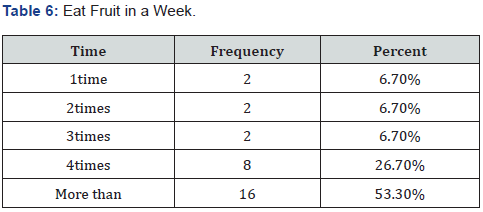
Drink Milk, Eat Butter, and Yogurt
Out of 30 sample size, 13.3% drank milk, ate butter and yogurt one time in week, 20% two times, 16.7% three times, 6.7% four times and 43.3% more than four times in a week. A similar study in India reported that Majority of girls (70.40%) and boys (71.07%) consumed milk and dairy products on daily basis [6-11]. This might be due to similar cultural preferences (Table 7).
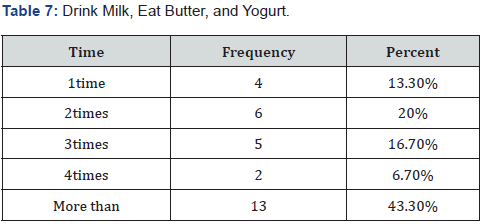
Drink Water in a Day
Among of 30 students, 6.7% drank water two times in day, 6.7% three times, 33.3% four times and 53.3% more than four times in day (Table 8).
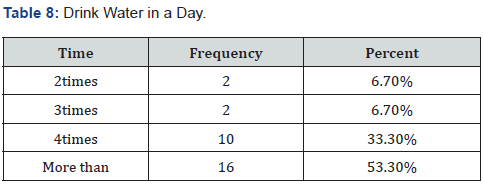
Bring Pocket Money for Lunch in a Week
20% of students brought pocket money for lunch from home one time in a week, 6.7% two times, 6.7% three times, 10% four times and 56.6% more than four times (Table 9).

Buy Eatable from Canteen in a Week

Among 30 students, 30% bought eatables one time from the canteen in a week, 13.3% two times, 10% three times, 3.4% four times and 43.3% more than four times. Similarly, Snacks and fast food was the most preferred food items for students reported by one of the studies (Mukherjee & Chaturvedi, 2017) (Table 10).
Play Game Daily
The fifty-six-point seven percent (56.7%) students played game one time in a day, 20% two times, 13.3% three times, 3,3% four times and 6.7% more than four times (Table 11).
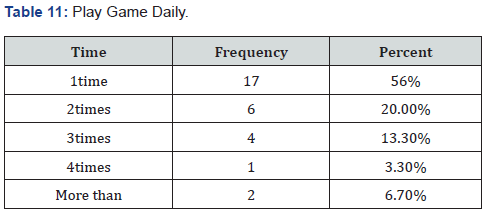
Hoteling in a Week
The ten percent (10%) student were never gone for hoteling in a week, 76.7% one time, 3.3% two times, 3.4% three times, 3.3% four times and 3.3% more than four times in a week (Table 12).
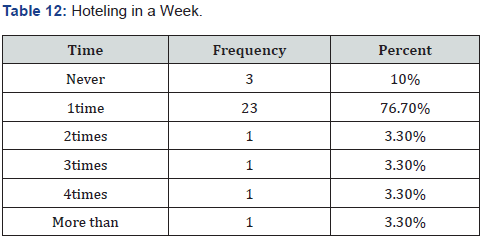
Get Sick in a Month
The twenty-six-point seven percent (26.7%) were never got sick in a month, 33.3% one time, 23.3% two times, 10% three times, 3.4% four times and 3.3% more than four times (Table 13).
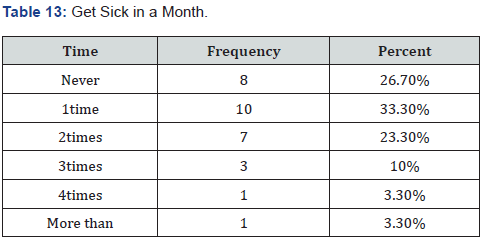
Sleeping Times Daily
The ten percent (10%) student were slept two times in a day, 6.7% four times and 83.3% more than four times. However, sleeping pattern was good (Table 14).

Limitations
Our study has certain limitations. Since it was a pilot study the data was collected from only one class in the age group of 10- 12 years hence it is representative of only the secondary school children and not children of all school going ages. Further, as the questionnaire was a self -administered one, it is possible that the responses of the students do not reflect the actual eating habits and preferences due to recall bias.
Recommendations
Awareness about healthy dietary habits in school children and for parents through Health Education with the help of community health nurses or school health nurse. Introduction of variety of food patterns to maintain a balanced diet. Promotion of physical activity along-with a healthy diet pattern for their better growth. Discourage the availability of junk food in school premises and promote home cooked food. Hence this was a pilot project this could be further explored on larger scale. In addition, the data can be collected from parents to see their diet preference for their children. Other age group can be covered in future to see the habits on larger scale. Moreover, pre-post can be conducted to guide the children in a better way.
Conclusion
On the basis of current study findings, it can be concluded that majority of students buy eatables items from canteen most frequently and bring lunch box very less time in a week. With recommended approaches it can be modified to develop health eating habits among middle-aged school children.
Acknowledgement
The authors are thankful to the administration of the schools for the permission to participate in the study.
Conflict of Interest
There is no conflict of interest among authors.
References
- ALBashtawy M, Alshloul, M, Alkawaldeh A, Freij M, Al-Rawajfah O, et al. (2014) Looking at School Nurses' roles in Tackling Overweight and Obesity. British Journal of School Nursing 9(8): 402–404.
- ALBashtawy M, Batiha A, Tawal beh L, Tubaishat A, AlAzzam M (2015) Self-Medication among School Students. J Sch Nurs 31(2):110–116.
- ALBashtawy M, Batiha A, Tawal beh L, Tubaishat A, AlAzzam M (2015) Self-Medication among School Students. J Sch Nurs 31(2):110–116.
- ALBashtawy M (2015) Exploring the reasons why School Students Eat or Skip Breakfast. Nursing Pediatric and Young People 27(6): 16–22.
- United Nations, Department of Economic and Social Affairs, Population Division (2015).
- World Population Prospects: The 2015 Revision, Key Findings and Advance Tables.
- Mukherjee R, Chaturvedi S (2017) A Study of the Dietary Habits of School Children in Pune City, Maharashtra, India. International Journal of Community Medicine and Public Health 4(2): 593-597.
- Buttriss J (2002) Nutrition, Health and Schoolchildren. Nutrition Bull 27: 275-316.
- Caine Bish N, Scheule B. (2007) Food Preferences of School Age Children and Adolescents in An Ohio School District. The Journal of Child Nutrition & Management 31(2).
- Kelder S H, Perry C L, Klepp K I, Lytle LL (1994) Longitudinal Tracking of Adolescent Smoking, Physical activity, and Food Choice Behaviors. Am Public Health 84(7): 1121-1126.
- Shi Z, Lien N, Kumar B N , Holmboe Ottesen G. (2005). Socio-Demographic Differences in Food Habits and Preferences of School Adolescents in Jiangsu Province, China. Eur J Clin Nutr 59(12): 1439-1448.






























